With evening’s last rays of light, Outdoor Oklahoma undergoes a subtle shift to a nocturnal lifestyle. Our daytime animals slowly fade into the darkness, while species more suited for the nightlife emerge. Short-eared owls lift from the grass to hunt the same prairies that northern harriers floated above earlier that day. Southern flying squirrels glide past the branches that eastern gray squirrels scurried over just hours before. Chimney swifts surrender the sky to bats, and lizards retreat into the night just as the toads and salamanders advance.
But what makes these animals more suited to the night?
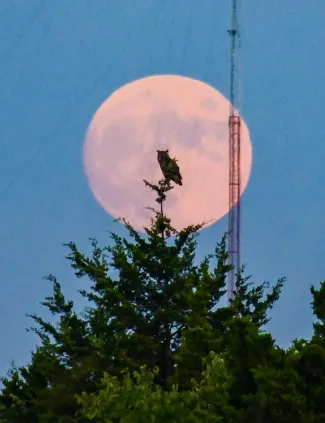
Most nocturnal animals have noticeably larger eyes than those animals active during the day. These oversize eyes and corresponding large pupils capture great amounts of light. Other visual adaptations can be found within the eye’s retina. Retinas are densely packed with visual cells, or photoreceptors, known as cones and rods. Cones have low sensitivity to light and are responsible for color vision. In contrast, rods are very sensitive to light and are responsible for night vision. Species active during the day, including people, have a higher proportion of cones, while species active at night, such as owls, have mostly rods.
Additionally, particles of light not captured by rods on the first pass can be reflected back by a layer of cells found behind the retina. This ensures as much light as possible is captured. These reflective cells, collectively known as the tapetum lucidum, not only help nocturnal animals see in the dark, but they also produce the glow seen when flashlights or headlights shine over the eyes of a striped skunk or coyote.
While these light-gathering capabilities are indispensable, other senses play a large role in nocturnal animals’ survival.
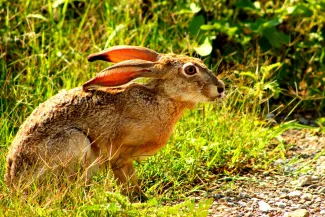
In addition to large eyes, the black-tailed jackrabbit, a nocturnal resident of the open plains, employs 7-inch-long ears and a keen sense of smell to pick up the slightest hint of a nearby predator. Barn owls use their uneven facial discs to detect whispers of sound, pinpointing the location of their next potential meal. A prairie kingsnake can identify the chemical signals, or scent trail, of a deer mouse by flicking its tongue in and out. Bats emit high-pitched sounds to navigate and locate food.
Whether traversing Oklahoma’s forests and prairies, hunting for food, or evading predators, our creatures of the night are tailored for their darkened surroundings.
Four Nocturnal Naturals
Nocturnal animals may share a few features that help them navigate their darkened domain, but their nighttime lifestyles don’t limit diversity. Mammals, birds, fish, insects, reptiles and amphibians of all sizes take to the night, exploiting the cooler temperatures and secrecy of the darkness. Here’s a closer look at four nocturnal animals that call Oklahoma home.
Ord’s Kangaroo Rat (Dipodomys ordii)
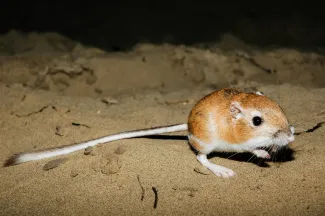
High jumpers of western Oklahoma’s sandy prairies, Ord’s kangaroo rats earn their name from pioneer American zoologist George Ord and their hopping mode of locomotion, similar to that of a kangaroo.
Often seen racing across sandy pasture roads at night, kangaroo rats use their elongated hind legs to bound across dunes, leap up to 6 feet in one hop and even kick sand at potential enemies. The smaller forelimbs are mainly used for feeding, but can also be drummed on the surface to communicate with other kangaroo rats. When escaping rattlesnakes, owls and badgers, kangaroo rats can make impressive sharp turns in midair! The long tail — 60 percent of their total length — helps kangaroo rats keep their balance during these high-speed maneuvers.
Ord’s kangaroo rats are variable in color. Kangaroo rats found in northwestern Oklahoma tend to be cinnamon toned. Kangaroo rats found in central Oklahoma, the eastern edge of the range, tend to be gray. Regardless of the body color, a white spot can be found over each eye and a white stripe crosses each hindquarter.
Kangaroo rats are primarily seed eaters, packing ragweed, sunflower and switchgrass seeds into their cheek pouches. Extra seeds are stored in burrows with multiple entrances. Populations of Ord’s kangaroo rats fluctuate with the availability of seeds, which in turn fluctuates with rainfall. Kangaroo rats are solitary and territorial; each burrow contains only one adult.
Luna Moth (Actias luna)
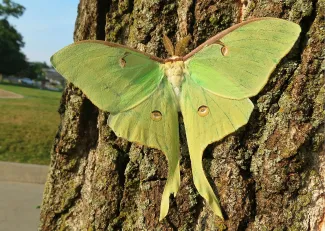
The first member of its family to be reported in literature, the luna moth was described and named in 1700. The scientific name was changed in 1758 to include “luna” because of the moonlike spots. Luna moths are sometimes referred to as the American moon moth.
A colorful creature of the night, luna moths can readily be recognized by their large size, pale green wings and long curling “tails.” Each of the four wings has a transparent eyespot and a pale pink edge. Similar to other moths, luna moths have feathery or comb-like antennae.
Luna moth eggs are laid on a variety of trees including black walnut and persimmon. Eggs hatch after one week, and the bright green caterpillars feed heavily on the host plant. After going through five molts in a month’s time, caterpillars spin a brown cocoon using silk and leaf litter.
Adults often emerge from the cocoon in morning and spend the day expanding and drying their large wings. Adult luna moths do not eat and must mate and lay eggs soon after they leave the cocoon.
Chuck-will’s-widow (Antrostomus carolinensis)
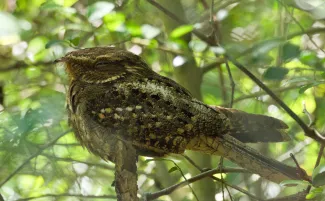
Named for its rolling “chuck-will’s-wid-ow” call, the chuck-will’s-widow is the largest nightjar found in Oklahoma. Nightjars are often referred to as goatsucker because of a myth that these birds feed on goat milk.
Considered one of spring’s many messengers, chuck-will’s-widows add their loud, rolling call to Oklahoma’s nightly chorus each April.
Like other nightjars, chuck-will’s-widows are well camouflaged, with brown, black and buff patterned feathers. They have a large, flat head and long tail and wings. Seldom seen, these birds can be identified by their namesake call alone. Though similar to the call of the whip-poor-will, you can distinguish the chuck-will’s-widow by the slower, lower pitched song.
A Neotropical migrant, this bird is only in the state for a brief spring and summer visit, taking advantage of our abundant insect populations. But in addition to eating moths and beetles, this bird will occasionally eat small birds — primarily migrating warblers — and even bats! When molting tail feathers in late summer, chuck-will’s widows have even been seen hunting frogs on the ground! Like other nightjars, chuck-will’s-widows have modified feathers, or bristles, that resemble whiskers around their beak. These bristles are used to guide flying insects into their large, open mouths when foraging.
Woodhouse’s Toad (Anaxyrus woodhousii)
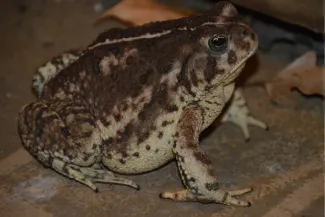
The largest toad in Oklahoma, the Woodhouse’s toad is named for Samuel Washington Woodhouse, a surgeon and naturalist who explored the southwestern United States in the mid-19th century.
A welcome guest in many yards and gardens, a single Woodhouse’s toad can eat thousands of insects each year! To avoid drying out, this toad often burrows into loose soil during the day but emerges at night to forage for insects and spiders.
Woodhouse’s toads are approximately 4 inches in length and have a light tan to dark gray back with scattered dark blotches. Each blotch contains two to four warts. There is usually a white to yellow stripe down the middle of the back.
Common across the state, this toad can be found in grasslands, open woodlands, agricultural fields and even residential areas. In fact, this toad is frequently seen sitting under streetlights as it hunts for insects. Breeding takes place from March to August in ponds, lakes, flooded areas and other bodies of water lacking strong current. The mating call is a high-pitched “whrrr” or “waaaah.”
To attract this toad and other amphibians to your property, spread 2 to 3 inches of mulch on the ground and place two small logs and a board over the mulch. A 3-by-3-foot pond of water can be added nearby to provide breeding habitat for the toads.